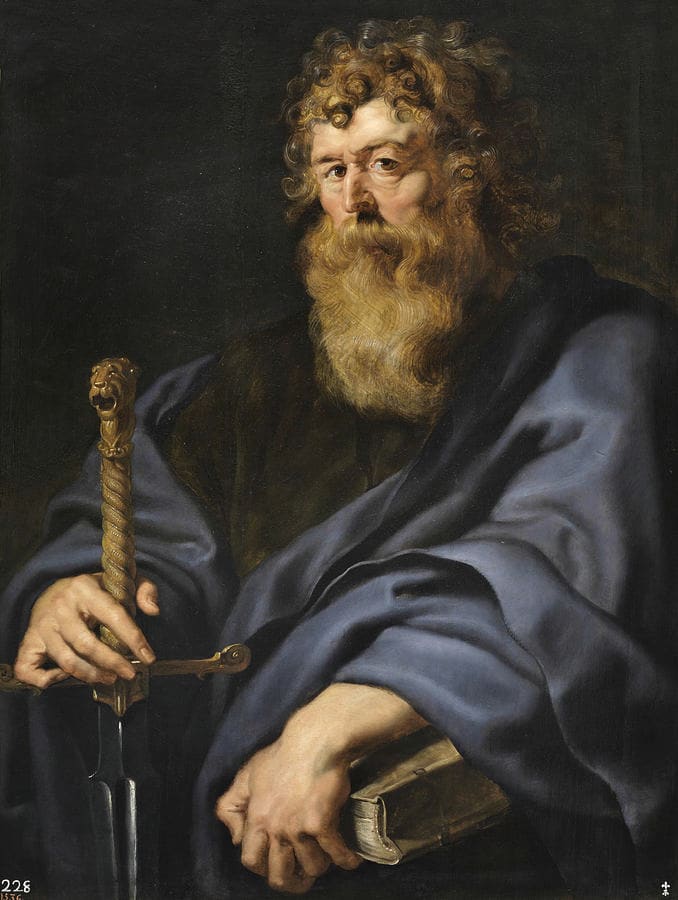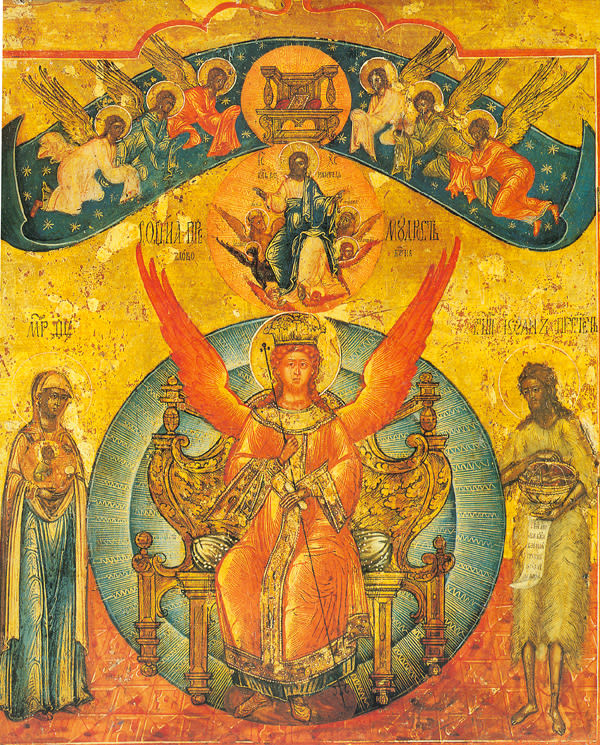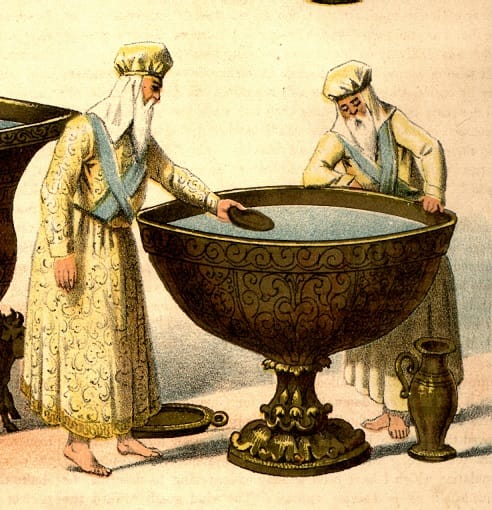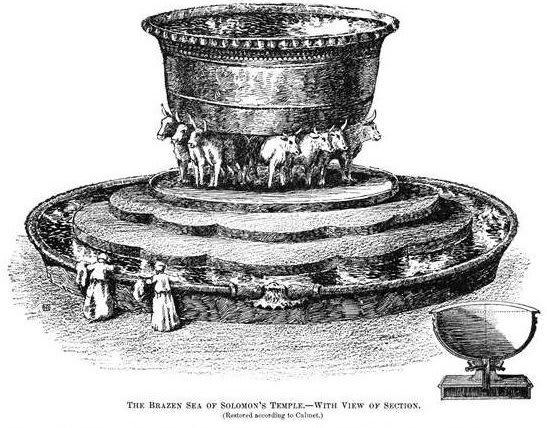I’ve tried to draw attention to various examples of ancient biblical cultural engagement with this blog. Here I want to take up one of the most challenging and perplexing instances of this, and also one of the most ultimately beautiful and symbolically rich. In this post, we will consider Isaiah 25 and how it resonates with the Baal Epic from Ugarit.
Baal Hadad, Rival to Adonai

Before I show how this beautiful section of Isaiah depends on the Baal Epic, let me offer a few words on the religion that produced this pagan poetry, from the perspective of the Hebrew Bible. If you have heard of Baal before, it is probably in the context of the narratives about ancient Israel’s proclivity to worship him as a rival to their own God. The story of the contest between Elijah and the prophets of Baal in 1 Kings is an especially vivid account that depicts the attraction that Israel had for Baal.
The reasons that Baal proved to be seductive are quite apparent if you understand what it is that he offered. Baal Hadad (“Hadad” is his proper name; “Baal” is a title meaning “lord”) was the deity who ruled over storms and all sorts of fertility. As a consequence, we discover that in the mythology he is constantly struggling against forces of infertility, like Yam (the salty, inundating sea) and Mot (“Death,” allied to the scorching summer sun). At one point in the story, a lesser god of fertility, Athtar, tries to take his throne, and this deity seems to symbolize water drawn up from wells, an artificial source of fertility, if you will. Even in much later rabbinic literature, non-irrigated fields are referred to as “fields of Baal.”
All this alone is enough to make Baal Hadad a charismatic deity. But the real cause of his popularity is that Canaan has an extremely well-defined weather pattern. It typically only rains between the months of October and April. Sometimes it rains very much in those months. When it does, crops are fruitful, and there will be plenty of food for all. But when it doesn’t rain enough, people get could get desperate. If it’s February, say, and you haven’t had an inch of rainfall yet, you would naturally want to seek help from a higher power, and beg for the release of those “latter rains.”
And, consider this: even if you were devoted to YHWH, the Creator, and God of your ancestors, you might conceive of Him as a sort of “jack-of-all-trades.” As powerful as Adonai is, He isn’t a specialist. He advertises Himself to be the only God Who really matters, the Lord of all. But in an emergency, when it begins to feel like Adonai has either forgotten you, or maybe can’t manage this particular problem, you can fall prey to the temptation to invoke an expert to solve this problem. Israelites who did this probably weren’t abandoning Adonai completely. They were simply turning to the other gods for particular problems. And more than any other god, Baal was the most attractive competitor for Israel’s devotion.
Baalism’s Dark Side
I’ll eventually get to the Baal Epic, and it will be easy to see how much I esteem this ancient work of poetry. This is why I want to make very clear right here that the cult of Baal Hadad was the focal point for many of the immoral behaviors that the Torah condemns.
The Baal Epic, as powerful as its symbols are, and as beautifully composed as it is, is an essentially amoral narrative, with an amoral hero. The moral universe of this text is downright Nietzschean. It celebrates Baal’s rise to power as he takes down one rival after another. Other Ugaritic texts concern themselves with questions of justice for the poor and vulnerable in society. There is not a whiff of justice in the Baal Epic. Even Shapsh, the god of the sun who typically champions righteousness, is depicted as little more than the lackey of the god of death, Mot. (This is logical, because there is a dichotomy in the text between the fertiltiy of Baal’s winter storms and the barren, sun-drenched summer).
Although necromancy doesn’t show up in the Baal Epic, this text provided a mythical backdrop for this type of divination. (Other Ugaritic texts describe rituals for inviting the spirits of the dead to a sacrificial banquet). Tombs have been discovered in Ugarit with holes drilled into them, probably for pouring libations and possibly foodstuffs through.
One of the major characters in the Baal Epic (and other Ugaritic literature) is the virgin-goddess Anat, Baal Hadad’s kid sister. Anat is a blood-thirsty and capricious deity. In another text, The Tale of Aqhat, she murders a young man because she covets his bow. In the Baal Epic, we first encounter her mowing through soldiers for fun. The poem describes heads and hands of these warriors flying through the air like locusts as she plows through them. When she concludes this battle, she sets up a banquet in her house, and invites young men for more carnage right there at the dinner table. Finally, when sated with war, she pours out the “oil of peace” into a bowl, and mops up the gore from the floor, walls, and furniture. Today, when we take such passages out of context, it is difficult to keep in mind that Anat is not a villain in the story, but one of the heroes who helps Baal achieve his dominion over the world.
And one of the ways that Anat does this is by finding a heifer with which Baal can mate before his battle with Mot. It seems like the idea is that by doing this, Baal leaves some of his life essence here on earth in the calves that he conceives. Anat slaughters a bevy of animals later in the story in her attempts to bring Baal back from the underworld. The text is fragmentary, but perhaps these calves are among the ritual victims. If so, the idea here is that the life Baal places in the womb of this heifer is later spilled out so as to give him the leverage he needs to ascend from the realm of the dead. Poetically and mythically, the idea works. But it all depends upon a ritual act of bestiality.
But the most disturbing aspect of the Baal cult is actually not explicitly mentioned in the Baal Epic, and that is child sacrifice. Once again, there is a poetic and mythic logic to it all. In a terrible drought, when it looks as though Baal is withholding his gifts of fertility, one might be tempted to bargain with him thus: “If I give you the product of my own fertility as a sacrifice, promise, I beg of you, to pour out your own fertility upon our barren land.”
For years there has been debate as to whether or not Canaanites actually committed such a heinous act. Many scholars have supposed that this was all a vicious slander that anti-Canaanite propaganda cooked up, first among the Hebrews, and later in Roman anti-Punic rhetoric.
But the archaeological evidence suggests otherwise.
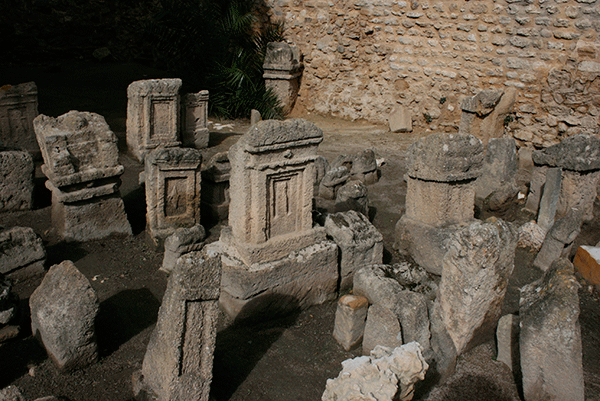
In tophets in Carthage, a Phoenician (Northern Canaanite) colony in North Africa, archaeologists have discovered hundreds of buried clay pots filled with the charred bones of infants. When I was studying at Ben-Gurion University, one of the archaeology professors delivered a lecture on this, and showed us inscriptions on these pots that said, “lmlk lb’l,” i.e., “for a moloch offering, for Baal.” (Moloch probably isn’t the name of a deity, but was actually the name of a type of sacrifice. The root mlk in Semitic languages means “king. So, a moloch offering was probably a “royal” offering). Interestingly, these child sacrifices were most common in the oldest layers. As time progressed, it seems that lambs were substituted in the place of the children.
In the Bible, Canaanite religion is depicted in grim and shocking ways that emphasize all of these immoral practices. Leviticus 20 is a great place to find all of these things (and more) clustered together. Unless you know something about Canaanite religion, these commandments can seem pretty random and arbitrary. (That’s surely why the editors of the NIV anemically label this chapter “Punishments for Sin”). But there’s a common theme behind these commandments against offering children as sacrifices, committing bestiality, and even the warnings to abide by the dietary code: Leviticus 20 is there to keep Israel separate from their Canaanite neighbors.
The Baal Epic
So, caveats acknowledged, allow me to provide a summary of the Baal Epic here, keeping in mind that the text is really fragmentary, and some of what follows amounts to conjecture.
Basically, the Baal Epic tells the story of how Baal’s shrine was established on Mount Tsaphon, and how he rose to power over all of the seventy sons of Il and Athirat. The narrative hinges around two major conflicts, one between Baal and Yam, the god of the sea, and the other between Baal and Mot, death. Both powers stand in the way of Baal Hadad’s forces of fertility.
Once Baal has disposed of Yam, he proceeds to go about building his mountain shrine/palace. This takes some doing, because first of all he has to get what amounts to a divine building permit from Il, the father of the gods. Il is reluctant to comply. It is not immediately evident why this is the case. Perhaps it is because Il favors Baal’s rivals. (Mot bears the epithet “Il’s beloved”). Personally, I think that it is because of his consort, Athirat, who would prefer to place her darling son, Athtar, on the fertility throne. (Later in the story, Athtar, who probably represents both Venus and the waters of irrigation, does attempt to sit on Baal’s empty throne, and discovers to his dismay that he is too small to sit on it and reign in Baal’s stead; Isaiah 14:13 seems to have incorporated this myth into the taunt-song against “Lucifer,” the “star of the morning”). In any case, with some violent coercion from little Anat, Il comes around to approving the construction of Baal’s palace.
Baal commissions the craftsman of the gods, Kothar-wa-Hasis, to build the temple for him. There is some back and forth between them about whether or not Baal’s home should have a window. Kothar-wa-Hasis thinks it should, but Baal resists the idea. Eventually, Kothar-wa-Hasis prevails. The window seems to be important for allowing Baal’s life-giving precipitation out into the world, but there may be another narrative function for the window. Jeremiah 9:21 speaks of death climbing in through windows. It’s possible that one of the lost fragments of the Baal Epic featured a scene in which Mot does just this.
In any case, the shrine is completed, window and all, and Baal invites all of the gods to a giant banquet to inaugurate it. Well, he invites nearly all of the gods. Mot’s name is conspicuously absent from the guest-list.
After the party is over, after the gods have returned to their homes, after all of the sacrificial meat has been consumed, and after the vats of wine have been drunk dry, Baal gets cocky. Sitting on his throne, he eyes the East, home of his rival, Mot, and he sends messengers to him to announce his coronation. But he gives them a stern warning.
But take care, divine servants:
Do not get too close to Divine Mot,
Do not let him take you like a lamb in his mouth,
Like a kid crushed in the chasm of his throat.
CAT 1.4, column VIII, lines 14-20, as translated by Mark Smith in Ugaritic Narrative Poetry
The problem with Mot is his insatiable hunger. He swallows up anything that gets near him. This is certainly a powerful mythic image for death! (And one that proved to be quite enduring, as we shall see).
Mot’s rejoinder to Baal is to the point.
Is my appetite the appetite of the lion in the wild,
Or the desire of the dolphin in the sea?
Or does it go to a pool like a buffalo,
Or travel to a spring like a hind,
Or, truly, does my appetite consume like an ass?
So will I truly eat with both my hands,
Or my portions amount to seven bowls’ worth,
Or my cup contain a whole river?
So invite me, O Baal, with my brothers,
Summon me, O Hadd, with my kinsmen,
To eat food with my brothers,
And drink wine with my kinsmen.
So let us drink, O Baal, that I may pierce you.
[… .]
When you killed Litan, the Fleeing Serpent,
Annihilated the Twisty Serpent,
The Potentate with Seven Heads,
The heavens grew hot, they withered.
So let me tear you to pieces,
Let me eat flanks, innards, forearms.
Surely you will descend into Divine Mot’s throat,
Into the gullet of El’s Beloved, the Hero.
KTU 1.5, Column I, lines 14-35
Tangent on Isaiah 27:1
Before we move on, please take note of that bit about Litan. This is the same reptilian monster that the Hebrew Bible calls “Leviathan.” And Isaiah 27:1 features a pretty close quotation from this section of the Baal Epic, although there YHWH, and not Baal, is the hero who vanquishes the dragon of the sea.
In that day the LORD with his hard and great and strong sword will punish Leviathan the fleeing serpent, Leviathan the twisting serpent, and he will slay the dragon that is in the sea.
Isaiah 27:1, RSVCE
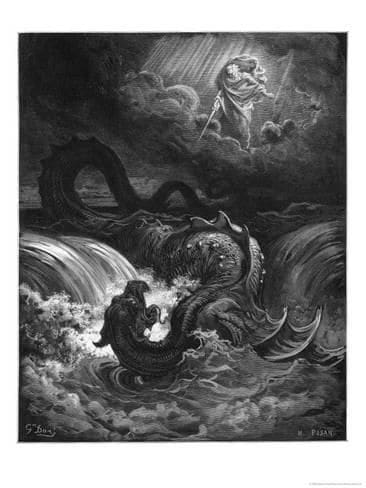
This section of Isaiah is part of what we call the “Isaian Apocalypse,” and the Baal Epic exerted a lot of influence over the whole thing. (More on that in a bit).
Baal’s Demise
Eventually, Baal does indeed descend into the throat of Mot. The consequences are immediate and devastating. An extended drought ensues, and all of the crops die. People and animals begin to starve to death. This adversely affects the gods, who enjoy the sacrificial offerings that result from the earth’s fecundity.
Baal’s death has transformed Il into a nostalgic Baal-fan-boy. He sits mourning and moping on his throne, cutting himself with a knife. (This is another Canaanite practice expressly condemned in the Torah).
Anat mourns, as well, but not like Il. Instead, she sets out in search of her brother. As she wanders the mountains, she comes upon his broken and defeated body. With the help of Shapsh, she loads him upon her shoulders and carries him back to his abode on Mt. Sapan. There, she buries him and performs the sacrificial funerary rites, slaughtering seventy each of buffalo, (the Ugaritic here suggests that the oryx may be intended), bullocks, sheep, deer, ibex, and donkeys.
Three days later, (!!!), Anat does something very strange: she goes looking for the brother that she has just buried. Accordingly, she goes straight to Mot, and demands that he disgorge Baal. Mot protests that he could hardly control himself, his appetite was so strong.
And so the drought continues for months more, until Anat hunts down Mot again. But this time, she does not interrogate him, but attacks him.
She seizes Divine Mot,
With a sword she splits him,
With a sieve she winnows him.
With a fire she burns him,
With millstones she grinds him,
In a field she sows him.
The birds eat his flesh,
Fowl devour his parts,
Flesh to flesh cries out.
KTU 1.6, column 2, lines 30-37
Baal’s Return
Immediately after Mot’s destruction, Il has a dream in which “the heavens rain oil, the wadis run with honey.” He understands this to mean that Baal has resurrected. Anat sets out to find her revived brother. As she does, she cries out “Iy zbl B‘l arṣ?”, i.e., “Where is the Prince, Lord of the Earth?” (Incidentally, the name of King Ahab’s notorious Phoenician queen, Jezebel, is taken from this part of the poem; in Hebrew/Canaanite, her name is pronounced “Iyzebel“).
We don’t have the portion of the poem in which Anat finds Baal, although it seems that she gets help from Shapsh once again. When the story picks up coherently, Baal is violently throwing down the “sons of Athirat” and the “young of Yamm” who have attempted to take his throne in his absence. Finally, he ascends to his throne once again and restores fertility to the parched earth.
All is well for seven years.
Not Exactly “Happily Ever After”
Somehow, at the end of these seven years, Mot returns, as well, and he immediately seeks a rematch with Baal. He accuses Baal for being the whole reason that Anat killed him and desecrated his body. As revenge, he demands one of Baal’s brothers, or maybe Baal himself, and storms off to gorge on human beings in the meantime.
Baal prepares a feast for Mot, under the illusion that he has slaughtered and prepared some of his own brothers for him. In fact, he has done so with Mot’s very own brothers! After Mot devours them, he somehow discovers the truth of the matter, and in his outrage, bears down on Baal to destroy him for good.
The battle between the two gods is violent and brutal. They “gore each other like buffalo” and “bit each other like serpents.” Finally, Shapsh cries out from heaven, like a celestial referee, and warns Mot that if he continues to challenge Baal, Il will surely strip him of his divine authority. Trembling, Mot sulks away, allowing Baal to resume his supervision over the forces of fertility.
Most scholars believe that this conclusion is not intended to have a sense of finality. Mot is still out there, threatening Baal’s life-giving forces. Indeed, the entire myth seems to symbolize the cycle of life and death that we see every year in the seasons, as well as the frequent experience of drought and famine followed by abundance with which everyone living in the ancient Levant was familiar.
So, at the end of the Baal Epic, Mot is not really defeated. He’s just subdued.
“He Will Swallow Up Death For Ever”
Now that we are familiar with the Baal Epic, we are prepared to appreciate what Isaiah does with it. As stated earlier, the part of Isaiah that is most influenced by the Baal Epic is the Isaian Apocalypse, chapters 24-27. At the heart of this text, there is a dramatic image of a feast prepared by the Lord on Mt. Zion. The imagery is evocative of all of the feasting in the Baal Epic.
6 On this mountain the Lord of hosts will make for all peoples a feast of fat things, a feast of wine on the lees, of fat things full of marrow, of wine on the lees well refined. 7 And he will destroy on this mountain the covering that is cast over all peoples, the veil that is spread over all nations. 8 He will swallow up death for ever, and the Lord God will wipe away tears from all faces, and the reproach of his people he will take away from all the earth; for the Lord has spoken.
Isaiah 25:6-8
Isaiah 25:8 explicitly mentions Mot. (The Hebrew word for death, mavet, is a precise cognate of Mot’s name). But Isaiah does more than just crib from the Baal Epic. Here, Mot, the terrifying swallower of all of the peoples, is himself swallowed. And unlike his encounters with Baal, Mot won’t come back from this one: “He will swallow up death for ever.” There is a finality to Mot’s defeat here that the Baal Epic does not dare to consider.
Jesus: More than Baal
Early Christianity probably didn’t have any of these Baal traditions readily at hand like the author of the Isaian Apocalypse did, but the Church preserved a lot of the symbolism in surprising ways, infusing them with new meanings that proclaimed the Gospel.
St. Paul is an early example of this. He cites (an alternate reading of) Isaiah 25:8, but appends to it a taunt-song that addresses “Death” as an anthropomorphized figure.
51 Lo! I tell you a mystery. We shall not all sleep, but we shall all be changed, 52 in a moment, in the twinkling of an eye, at the last trumpet. For the trumpet will sound, and the dead will be raised imperishable, and we shall be changed. 53 For this perishable nature must put on the imperishable, and this mortal nature must put on immortality. 54 When the perishable puts on the imperishable, and the mortal puts on immortality, then shall come to pass the saying that is written:
“Death is swallowed up in victory.”
1 Corinthians 15:51-55
55 “O death, where is thy victory?
O death, where is thy sting?”
Those words, as far as we know, were composed in the Christian era, but they certainly would not be out of place in a piece of Ugaritic epic.
In the centuries that followed, the drama of Christ’s victory over death was celebrated in similarly mythic terms, especially in speculation over just what happened when He “descended into hell.” One of the earliest examples remains among the most colorful, as well, from the apocryphal Gospel of Nicodemus. Just look at what happens when Jesus arrives at the gates of hell:
VI (XXII)
1 When Hell and death and their wicked ministers saw that, they were stricken with fear, they and their cruel officers, at the sight of the brightness of so great light in their own realm, seeing Christ of a sudden in their abode, and they cried out, saying: We are overcome by thee. Who art thou that art sent by the Lord for our confusion? Who art thou that without all damage of corruption, and with the signs (?) of thy majesty unblemished, dost in wrath condemn our power? Who art thou that art so great and so small, both humble and exalted, both soldier and commander, a marvelous warrior in the shape of a bondsman, and a King of glory dead and living, whom the cross bare slain upon it? Thou that didst lie dead in the sepulchre hast come down unto us living and at thy death all creation quaked and all the stars were shaken and thou hast become free among the dead and dost rout our legions. Who art thou that settest free the prisoners that are held bound by original sin and restorest them into their former liberty? Who art thou that sheddest thy divine and bright light upon them that were blinded with the darkness of their sins? After the same manner all the legions of devils were stricken with like fear and cried out all together in the terror of their confusion, saying: Whence art thou, Jesus, a man so mighty and bright in majesty, so excellent without spot and clean from sin? For that world of earth which hath been always subject unto us until now, and did pay tribute to our profit, hath never sent unto us a dead man like thee, nor ever dispatched such a gift unto Hell. Who then art thou that so fearlessly enterest our borders, and not only fearest not our torments, but besides essayest to bear away all men out of our bonds? Peradventure thou art that Jesus, of whom Satan our prince said that by thy death of the cross thou shouldest receive the dominion of the whole world.
2 Then did the King of glory in his majesty trample upon death, and laid hold on Satan the prince and delivered him unto the power of Hell, and drew Adam to him unto his own brightness.
But perhaps the Christian visual arts have most retained the Ugaritic imagery of death. Consider this depiction of the harrowing of hell:
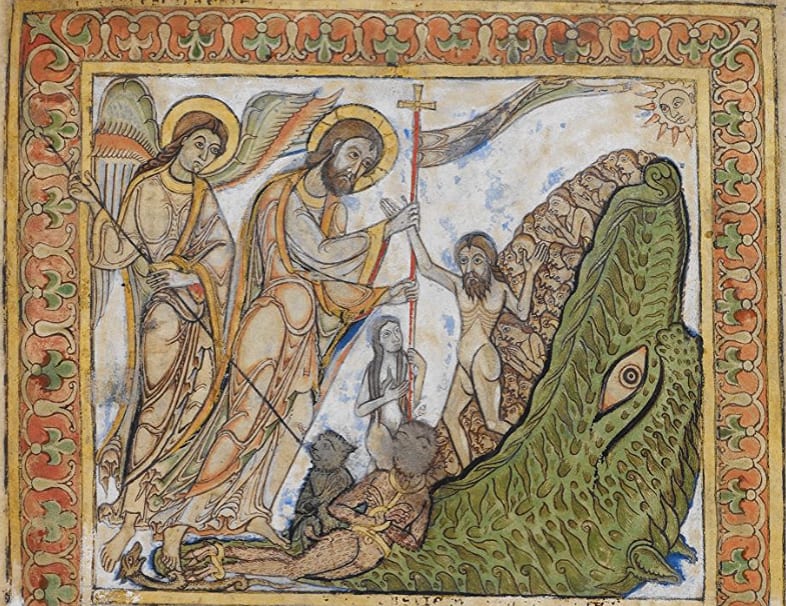
This image of death (and it is not unique) is essentially identical to Mot, the great swallower of humanity. The illumination portrays Jesus serenely disgorging Mot’s stomach of the souls awaiting redemption, beginning with Adam and Eve, our first parents.
Of course, our celebration of Easter is riotous with imagery of fertility that just barely glosses over our older, pagan celebrations of the oncoming of Spring. Eggs, bunny rabbits, and flowers are not symbols of resurrection, but of the more general power of life that bursts out around us after the “death” of winter. Jesus, Lord of Life that He is, has thus usurped the impostor, Baal Hadad, and proven Himself to be the True God of all, including life and fertility.

What impresses me with the way that the Gospel has taken up these pagan motifs is that, rather than simply dismissing them as in error, Christianity affirms what was good and true about the longings expressed in the old myths. C.S. Lewis wrote about this phenomenon, and called those longings the “happy dreams of pagans.” The Gospel doesn’t just fulfill the promises of the Old Testament, but the promises envisioned, however dimly, in every culture around the world.
But Jesus is always more. The Baal Epic ends with a hopeful, but ultimately ambiguous conclusion. Baal reigns to provide fertility to the world, but the reader can’t help but suspect that it won’t be long before Mot has swallowed him up yet again. Not so with the Gospel. Jesus has utterly vanquished death, and can never be threatened by it again. (And He doesn’t need any help from a little sister, either!). As Christians, we can revel in His victory, anticipating our own eventual triumph over Mot.





